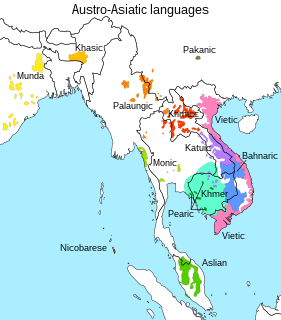
The Austroasiatic languages, also known as Mon–Khmer, are a large language family of Mainland Southeast Asia, also scattered throughout India, Bangladesh, Nepal and the southern border of China, with around 117 million speakers. The name Austroasiatic comes from a combination of the Latin words for "South" and "Asia", hence "South Asia". Of these languages, only Vietnamese, Khmer, and Mon have a long-established recorded history, and only Vietnamese and Khmer have official status as modern national languages. In Myanmar, the Wa language is the de facto official language of Wa State. Santali is recognized as a regional language of India. The rest of the languages are spoken by minority groups and have no official status.

The Degar, also known as Montagnard, are the indigenous peoples of the Central Highlands of Vietnam. The term Montagnard means "people of the mountain" in French and is a carryover from the French colonial period in Vietnam. In Vietnamese, they are known by the term người Thượng (Highlanders)—this term now can also be applied to other minority ethnic groups in Vietnam or Người dân tộc thiểu số. Earlier they were referred to pejoratively as the mọi.

Tây Nguyên, translated as Western Highlands and sometimes also called Central Highlands, is one of the regions of Vietnam. It contains the provinces of Đắk Lắk, Đắk Nông, Gia Lai, Kon Tum, Lâm Đồng.
The Chamic languages, also known as Aceh–Chamic and Achinese–Chamic, are a group of ten languages spoken in Aceh and in parts of Cambodia, Vietnam and Hainan, China. The Chamic languages are a subgroup of Malayo-Sumbawan languages in the Austronesian family. The ancestor of this subfamily, proto-Chamic, is associated with the Sa Huỳnh culture, its speakers arriving in what is now Vietnam from Borneo or perhaps the Malay Peninsula.

The Mnong or Munong are an ethnic group from Vietnam and Cambodia.
The Pnong are an aboriginal Cambodian minority ethnic group. They are found primarily in Mondulkiri province of Cambodia. The Pnong is the largest indigenous highland ethnic group in Cambodia. They have their own language called Pnong, which belongs to Bahnaric branch of Austroasiatic languages. The majority of Pnong people are animists, but a minority of them follows Roman Catholicism and Theravada Buddhism. The Pnongs are considered as Khmer Loeu or Montagnard, which is the collective name given to the various indigenous ethnic groups residing in the highlands of Cambodia.
The Stieng people are an ethnic group of Vietnam and Cambodia. They speak Stieng, a language in the Bahnaric group of the Mon–Khmer languages.

There are two scripts in Southeast Asia called Khom script. This article describes the obscure script from Laos that Sidwell (2008) and Jacq (2001) have described under the name "Khom script".
Oi is a Mon–Khmer dialect cluster of Attapeu Province in southern Laos. The dominant variety is Oy proper, with 11,000 speakers who are 80% monolinguals. The Jeng (Cheng) speak the same language but are ethnically distinct. Speakers follow traditional religions.
Chrau(also known as Jro, Ro, Tamun, Charuo, Choro, Chíoro) is a Bahnaric language spoken by some of the 22,000 ethnic Cho Ro people in southern Vietnam. Unlike most languages of Southeast Asia, Chrau has no lexical tone, though it does have significant sentence intonation.
Brao is a Mon–Khmer language of Cambodia and Laos.
Su' is a Mon–Khmer language of the Bahnaric branch spoken in Attapeu Province, Laos. The 1995 Attapeu census recorded a population of only 124 speakers in Sanamsay District. Su' autonyms are identical with that of the Jru', but they consider themselves to be a separate ethnic group. There could also possibly be speakers in Stung Treng Province, Cambodia.
Taliang is a Bahnaric language of Laos. It is possibly the same as the Stieng language of Vietnam and Cambodia.
Tampuan is the language of Tampuan people indigenous to the mountainous regions of Ratanakiri Province in Cambodia. As of the 2008 census there were 31,000 speakers, which amounts to 21% of the province's population. It is closely related to Bahnar and Alak, the three of which form the Central Bahnaric language grouping within the Mon-Khmer language family according to traditional classification. Sidwell's more recent classification groups Tampuan on an equal level with Bahnar and the South Bahnaric languages in a larger Central Bahnar group. The Tampuan language has no native writing although in 1997, a bilingual education pilot project ran by the Cambodian government, UNESCO and various NGOs developed a script based on the Khmer alphabet to write Tampuan. The modified Khmer script was approved in 2003 for use in educating Tampuans in their native tongue.
Jru' is a Mon–Khmer language of the Bahnaric branch spoken in southern Laos. It is also known as "Loven", "Laven" or "Boloven" from the Laotian exonym Laven or Loven, which is derived from the Khmer name for the Boloven Plateau. The Jru' people engage in coffee and cardamom cultivation, as well as other agricultural activities.
Khmer Khe is a Khmeric language spoken in Stung Treng Province, Cambodia. It has an estimated lexical similarity of between 95-96% with Central Khmer.
Mel and Khaonh constitute a Bahnaric language of northeastern Cambodia.
Thmon is a Bahnaric language of northeastern Cambodia.





